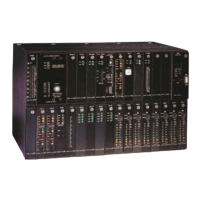Chapter 2. Applications
44
Drop-and-insert operation is ideal for polled data networks. A data line card at a control center
sends data on one of the T1 channels to all the data line cards that occupy the same DS0
transmission channel. Only the polled Data Terminal Equipment (DTE) will communicate back to
the control center. (In this network configuration, the T1 carriers must have the same timing
source.)
Dual Channel Bank
Dual channel bank operation allows public and private networks to be easily merged. The T1 ports can
be connected to separate communications carriers, or to private networks. Figure 2-4 illustrates radio
station operation, and depicts a dual channel bank network.
Figure 2-4. Dual Channel Bank Network
Voice, Video, and Special Services Networks
Dual channel bank operation is ideal for audio and compressed video networks. From the public
network, standard telephone lines, 800 lines, and syndicated radio shows are brought into the
studio. FXS cards are used for the voice traffic, and Digital Program Channels (DPCs) are used
to bring in high-quality audio from the special services network for the syndicated radio shows.
The T1-2 port connects to a private network to access a remote studio. Live performances are
broadcast from the remote studio over DPCs. A compressed video signal from the remote studio
helps queue the music. The compressed video is carried over a high-speed data channel. A
control voice channel between the station and remote studio, implemented with the Omni-
orderwire line card, is used for standard voice communication generally used for station to station
(troubleshooting) where voice quality is not an issue.

